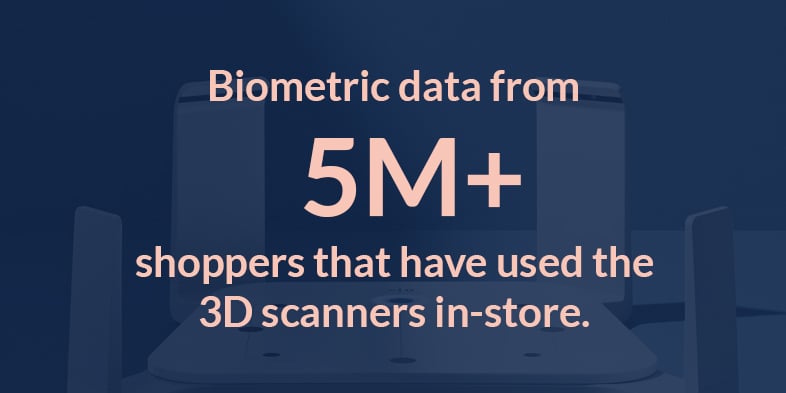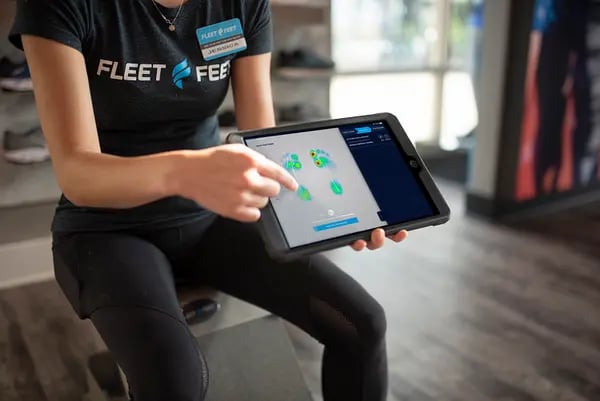In 2018, specialty footwear retailer Fleet Feet wanted to gain a better understanding of the foot measurements of its customers. The company turned to Volumental to install its 3D foot scanners across Fleet Feet’s entire network of retail stores.

Since establishing its Fit ID outfitting process powered by Volumental’s technology, the retailer has further refined its measurement capabilities to match the right shoe style and size to the right shopper, while also improving the fit of the insoles it offers. This process has allowed Fleet Feet to collect biometric data from more than five million shoppers that have used the 3D scanners in-store. The state-of-the-art scanner takes precise measurements of a shopper’s foot length, width and arch height based on 11 data points, all in less than five seconds. The system then creates a profile that store associates can match with the perfect shoe.
Digging Deeper on Shopper Needs
Fit ID has enabled Fleet Feet to discover details that give them a richer, more accurate understanding of overall shopper footwear needs. One notable “aha moment” was learning that 20 percent of its customers have at least a half-size difference between each of their feet. The company also found that women, much more so than men, require a shoe that is more narrow or wider than the average width shoe.
These discoveries convinced Fleet Feet of the need to move beyond static measurements to better personalize the footwear buying experience. In September 2020, the retailer expanded the boundaries of the Volumental technology by integrating dynamic pressure mapping from Superfeet, which measures the unique foot path and weight distribution of each foot.
The dynamic data captured in store enabled the retailer to better recommend trim-to-fit and specialized insoles from Superfeet. The 3D-printed insoles are shaped to match the arch and heel contours of each user. Each individual insole has five independent zones that are tuned to adapt and respond to the way the foot moves.
3D Plus Mapping, a One-Two Punch
When shoppers enter Fleet Feet stores, they are automatically steered through two types of measurements: the static 3D scan , where they stand on the 3D foot scanner - the scan is then completed in 4 to 5 seconds; and the dynamic pressure mapping system, where they walk across a short force plate, which takes another 20-30 seconds. Fleet Feet outfitters can then share key observations about the customer’s scan data on an iPad, which is always an eye-opening experience for customers.

“We can now capture both dynamic and static data points for each person’s feet and then showcase both of those visualizations to our customers,” said Victor Ornelas, director of brand management at Fleet Feet. “This combination of 3D scanning and dynamic mapping is like a one-two punch that allows our customers to ‘see their feet the way we do.’ It also provides transparency and detail to further establish our trust and credibility as a specialty retailer.”
Conversation Starter with Customers
Victor adds that the dynamic pressure mapping hardware is an added conversation starter between Fleet Feet outfitters and customers with respect to the benefits of personalized, trim-to-fit insoles for performance, comfort and pain relief.
Superfeet uses the 3D and pressure mapping data collected in Fleet Feet stores to 3D print each ME3D insole in its manufacturing facility in Ferndale, Wash., before shipping to the customer. The facility uses prototyping materials, 3D printers and machines to vary production from a single custom pair of insoles up to thousands of pairs.
Victor explains that the value of the Volumental-Superfeet collaboration goes well beyond personalizing insoles.
“Our mission is to find solutions for our customers, and now we have another solution that also accentuates our existing in-store insoles,” he said. Victor acknowledged that the most appealing opportunity for Fleet Feet is in “scaling what happens physically in-store, outfitter-to-customer, every day in 180-plus locations, and to the masses via strategic, omnichannel touchpoints.”
3D Scanning Timely During Pandemic
While the enhanced version of Fit ID debuted when shoppers were hesitant to shop in stores or try on shoes due to COVID-19 fears, more consumers are becoming comfortable with in-store footwear fitting. In addition, Volumental’s 3D scanner allows for social distancing, to reduce the level of contact between store associates and customers.
Victor noted that during the earlier stages of the pandemic, Fleet Feet’s digital and retail operations teams quickly helped the retailer roll out added services like curbside pickup and virtual outfitting appointments. Being able to reference a customer’s prior foot scan during the appointment was useful in helping Fleet Feet boost consumer loyalty.
Staying Top-of-Mind with Consumers
He explains that all these measures have been critical for the retailer to retain, engage and remain top-of-mind among customers. “It’s also really important in reaching new customers and defining what it is that Fleet Feet can provide – data-driven insights, personalized solutions, premium products, ongoing support, and unique experiences,” Victor emphasized.
